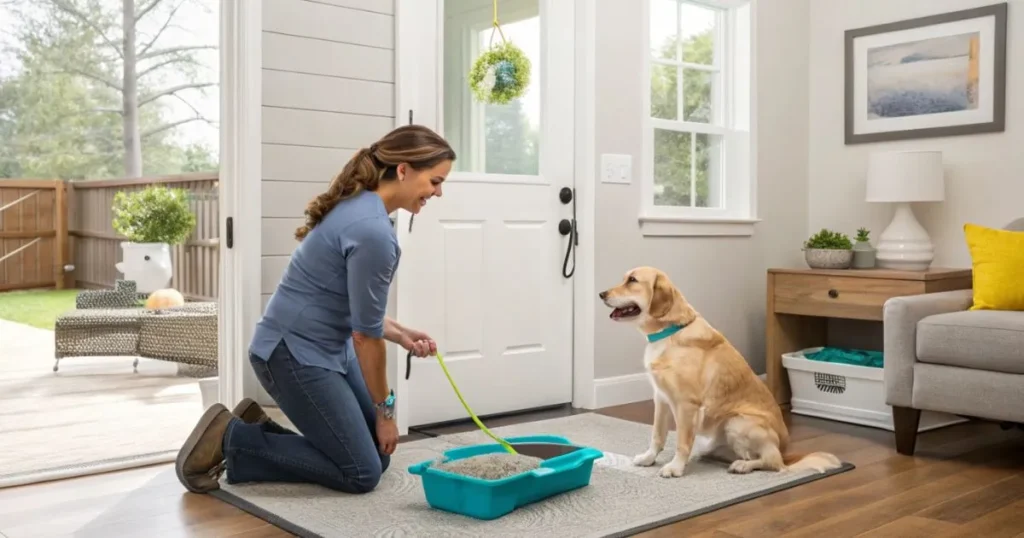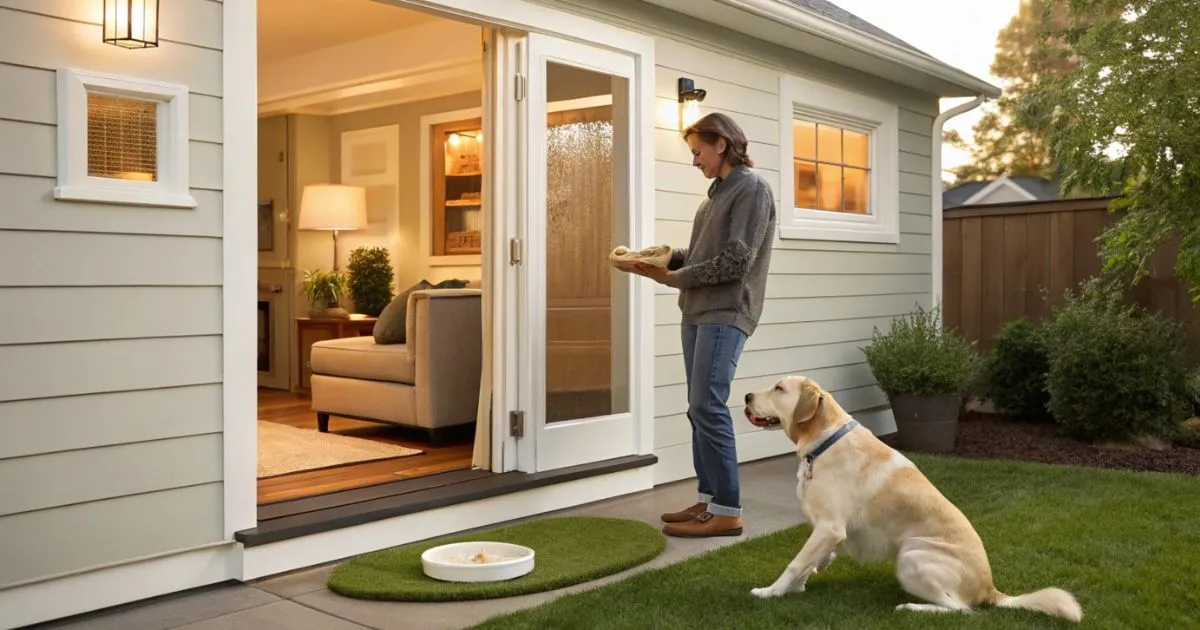Bringing an older dog into your home can be incredibly rewarding. Yet, it comes with its own set of challenges, especially with housetraining. Many pet parents worry they must teach an adult dog like a puppy. But, *house training an adult dog* is definitely possible and can strengthen your bond.
As Irith Bloom, CPDT-KSA, CDBC, points out, the early stages of adult dog potty training require patience and effort. But the rewards are well worth it. By understanding your dog’s needs and setting a consistent routine, you can successfully *housebreak an older dog*. Your journey to becoming a skilled dog owner begins here.
Table of Contents
Understanding Adult Dog Potty Training
Potty training an adult dog might seem tough, but it’s doable and crucial. Many think older dogs can’t be trained, which is a big misconception. Knowing that adult dog potty training is possible helps you create a good training space.
Adult dogs can learn to go potty in the right spot in a few weeks. Sometimes, small or older dogs might need more time, even months. But, dogs are only considered potty trained after they’re accident-free for a month. This shows the importance of being consistent and patient.
To train effectively, use leashes, watch them closely, and keep them in a certain area. These steps help create a routine for older dogs. This routine should include times for eating, walking, and bathroom breaks. These patterns help build trust and understanding between you and your dog.
Accidents happen during housetraining, so it’s key to handle them calmly. Yelling at your dog can confuse them, making them think you’re upset about their natural actions. Cleaning up without showing anger keeps the learning environment positive.
Regular breaks and walks are good for both potty training and keeping your dog happy. Training methods like crate training work for dogs of any age. A crate that fits your dog right offers a safe space to learn good habits.
In short, knowing the basics of adult dog potty training lets you tackle it with confidence. Focus on routine, watching them, and using positive methods. Your adult dog can learn to go potty where they should.
Common Myths About Housetraining Older Dogs
Many people believe misconceptions about dog training, especially with older dogs. They think adult dogs can’t learn new habits. But, research proves that housebreaking an older dog is possible with the right approach.
Consistent schedules and positive reinforcement are key. These help older dogs learn and adapt.
Another myth is about how often older dogs need to go outside. Senior dogs might have smaller bladders, needing more frequent breaks. Small breeds need more potty breaks than big ones.
Creating a routine helps prevent accidents. Sometimes, accidents are due to health issues, not bad behavior. Regular vet visits can find health problems that affect house training.
The umbilical cord method helps limit accidents. It means keeping your dog in sight always. This way, you can spot when they need to go outside.
It usually takes two weeks to see progress. But, being patient is important. This method helps show that older dogs can learn new things.
Positive reinforcement is vital in dog training.It strengthens the connection between you and your dog. This makes them more eager to learn and please you.
Many find this method better than punishing them. Punishment can cause stress and make training harder.
How to House Train an Adult Dog: Essential Steps
House training an adult dog needs commitment and consistency. It’s important to have structured routines and watch your dog closely. Follow these steps for a smooth transition for your furry friend.
Creating a Routine for Your Dog
Creating a routine helps a lot in house training adult dogs. Try to keep things regular with set meal times and potty walks. Dogs can take different amounts of time to learn, from weeks to months.
Look for signs that your dog needs to go outside. These include:
- Barking at or scratching the door
- Sniffing the ground
- Restlessness and circling
When you see these signs, take your dog outside right away. Use a leash to guide them and reward them with treats or praise. This helps them learn their new routine.
The Importance of Supervision
Watching your dog closely is key in training them. Use baby gates or keep them in a small area. This stops accidents and lets you watch their behavior.
If accidents do happen, clean up with an enzymatic cleaner. This removes smells that might confuse your dog.
Keeping an eye on your dog helps you understand their habits. This knowledge is important for a reliable routine. It leads to a successful and happy house training experience.
Using Positive Reinforcement Techniques
Positive reinforcement is key in dog training, especially for adult dogs. It encourages good behavior and builds trust. When you reward your dog for going potty in the right spot, it makes them want to do it again. Knowing how to use rewards well can make housetraining easier.
Rewards and Treats for Successful Potty Breaks
Using high-value treats can really motivate your dog. Choose rewards that make your dog excited. Bloom suggests using calming praise and treats when your dog goes potty where they should. This shows them that good potty breaks are fun.
Here are some key benefits of using rewards during adult dog toilet training:
- Promotes positive associations: Your dog learns to link good behavior with fun rewards.
- Increases eagerness to learn: Dogs trained with positive reinforcement are more eager to learn.
- Reduces anxiety: Not punishing them helps avoid fear and anxiety, which can slow down training.
- Strengthens the bond: Rewarding good behavior makes your bond with your dog stronger.
Keep track of your dog’s progress with a training chart. This helps you stay consistent and celebrate their successes. As time goes on, your dog will understand what you expect, making training easier.

| Reward Type | Description | Timing |
|---|---|---|
| Treats | Small, tasty snacks that your dog loves | Immediately after successful elimination |
| Praise | Verbal affirmations and petting | At the moment of success |
| Playtime | Engaging in a fun activity, like fetch | After consistent success over several days |
Positive reinforcement makes dog training rewarding for both you and your dog. It sets a strong foundation for successful toilet training and better behavior.
Crate Training for Adult Dogs
Crate training is an excellent method for house-training adult dogs. It offers many benefits, like safety and preventing bad habits. Choosing the right crate size and spot makes your dog feel safe and happy, helping them learn good habits.
Choosing the Right Crate Size and Location
Size and where you put the crate are key for adult dog training.The crate should be spacious enough for your dog to stand, turn around, and lie down comfortably. A crate that’s too small can make your dog uncomfortable, while a too-large one might make them use it as a bathroom.
- Plastic Crates: Provide a sturdy, private space.
- Wire Crates: Are easy to clean and let in air.
- Soft-Sided Crates: Are light and good for calm dogs.
- Furniture-Style Crates: Look good and serve a purpose.
place the crate in a quiet spot, away from busy areas.This creates a calm and comfortable space for your dog. Start slow and positive to help your dog see the crate as a safe space.
Make the crate a part of your dog’s daily life.Encourage them to adjust by offering treats or toys. This makes the crate a happy place, reducing stress and making your dog feel at ease.
Managing Accidents and Setbacks
Accidents are part of house training. Knowing how to handle them can greatly improve your training. Stay calm when accidents happen. This helps your dog learn better.
Make sure to clean up well. And also, watch for any health issues in your dog.
Cleaning Up Accidents Properly
Cleaning up dog accidents is key. It keeps your home clean and stops accidents from happening again. Use a special cleaner for pet stains to get rid of smells.
Here’s how to clean up:
- Use paper towels to blot the area and absorb excess moisture..
- Put the enzymatic cleaner on as the instructions say.
- Let it sit for the time suggested to break down smells.
- Wash with water and dry with paper towels.
By cleaning up like this, your dog will learn where not to go.
Recognizing Signs of Medical Issues
Some accidents might mean your dog has a health problem. Watch your dog for signs of illness. If accidents keep happening or your dog’s bathroom habits change, call your vet.
Look out for these signs:
- Going to the bathroom a lot
- Struggling to go
- Changes in eating or acting
- Blood in pee or poop
These could mean your dog needs a vet check. Routine vet check-ups allow for early detection of health issues.
Tips for Consistency and Patience
Training an adult dog needs a lot of commitment to consistency and patience. Paying close attention to your routines is key to your dog’s success in housetraining. Keeping track of your dog’s progress can give you valuable insights and help you improve your training methods.
Using a housetraining chart can make this easier. It lets you monitor your dog’s behaviors and patterns well. Adult dog training consistency is crucial, especially for dogs from tough backgrounds, like shelters.
Tracking Progress with a Housetraining Chart
A housetraining chart is a great tool for tracking your dog’s progress. It can include:
- Date and time of each potty break
- Observations on bathroom habits
- Successes and setbacks
By noting these details, you can find the best times for potty breaks. Adult dogs might need fewer trips outside, but they still need regular breaks. This method helps keep training consistent.
Tracking your dog’s progress lets you celebrate their achievements and make needed changes. Knowing when your dog needs to go out helps make routines stronger. Consistent rewards, like treats, encourage good behavior. Each entry in your chart helps you understand your dog’s housetraining better.
Conclusion
House training adult dogs needs a consistent routine, careful watching, and positive rewards. A structured schedule with regular breaks helps a lot. Remember, accidents can still happen, but they’re part of learning.
Be patient, as changing your dog’s habits can take weeks to months. Older dogs might face more challenges, so be extra kind and supportive. Following this guide will help you have a happy, well-trained dog.
If you’re still facing problems, talk to a vet or a dog trainer for help. With kindness and determination, you’ll create a great learning environment for your dog.
